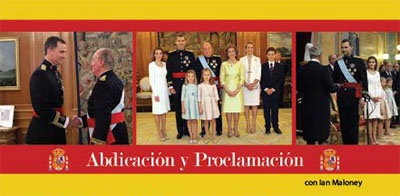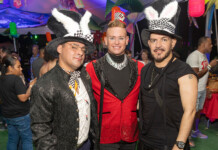Felipe VI asciende al trono de España
El pasado mes de junio, el rey de España, Don Juan Carlos de Burbon y Burbon, anunció su decisión de abdicar el trono después de 39 años de reinar; tomó control del país en 1975 cuando el dictador Gen. Francisco Franco murió tras decidir que la monarquía debe volver al poder.
El heredero al trono español, Felipe, tercer hijo (pero el único varón) de Don Juan Carlos y su esposa Doña Sofía de Grecia, recibió el titulo de Príncipe de Asturias cuando su padre ascendió al trono. Hace 10 años, Felipe se casó con Letizia Ortiz, una periodista asturiana de la clase media. (La primera princesa, ahora reina de España, que no viene de la nobleza del país.) La pareja tiene dos hijas, Leonor, la nueva Princesa de Asturias de ocho años y la Infanta Sofía que tiene siete años.
Oficiales españoles se prepararon para la Proclamación que se llevó al cabo el pasado 19 de junio. Las calles madrileñas estaban engalanadas con la bandera española y miles de gente llegó a la ruta oficial para ver a los nuevos reyes.
El sistema del gobierno español es una monarquía constitucional así que el rey no tiene poder actual pero sí es la cabeza del estado y el Capitán General de las fuerzas armadas. El último acto oficial de Don Juan Carlos era pasar el control de las fuerzas españoles a su hijo, el nuevo rey Felipe VI. En un acto público y simbólico en el Palacio La Zarzuela, casa de la familia real, Felipe VI recibió el Fajín Rojo del Capitán General.
Después de la ceremonia en la Zarzuela, los reyes, salieron del palacio en el Rolls Royce del Patrimonio Español para ir al Congreso de los Diputados. Al llegar el nuevo rey juró su lealtad a la constitución española y estaba proclamado Rey Felipe VI.
 La ceremonia en el hemiciclo ante los funcionarios electos estaba seguido por un desfile militar. Entonces la familia real pasaron al Palacio Real. Felipe y Letizia viajaron en un coche descapotable, el nuevo rey de pie saludando a la gente. El Palacio Real es el sede oficial de la Familia Real Española, aunque no viven allí. Al llegar al Palacio Real, la familia entera salió al balcón de los príncipes para saludar al público por primera vez como reyes.
La ceremonia en el hemiciclo ante los funcionarios electos estaba seguido por un desfile militar. Entonces la familia real pasaron al Palacio Real. Felipe y Letizia viajaron en un coche descapotable, el nuevo rey de pie saludando a la gente. El Palacio Real es el sede oficial de la Familia Real Española, aunque no viven allí. Al llegar al Palacio Real, la familia entera salió al balcón de los príncipes para saludar al público por primera vez como reyes.
Es verdad que parte del pueblo español no apoya a la monarquía, pero es obvio que los reyes nuevos se han dedicado sus vidas a servir la gente. La situación económica y política va cambiando por todo el país, pero Felipe VI ha prometido mantener una posición neutral para asegurar que la corona puede “facilitar el equilibrio con los demás órganos constitucionales y territoriales, favorecer el ordenado funcionamiento del Estado y ser cauce para la cohesión entre los españoles.”
Last month, the King of Spain, Don Juan Carlos de Burbon y Burbon announced his decision to abdicate the throne after a 39-year rein. He took control of the country in 1975 when the dictator General Francisco Franco died after deciding that the monarchy should return to power.
The heir to the Spanish throne, Felipe, third child (and only son) of Don Juan Carlos and his wife Doña Sofía of Greece, was granted the title of Prince of Asturias when his father ascended to the throne. Ten years ago, Felipe married Letizia Ortiz, a news reporter from Asturias and also a commoner. (She became the first princess, now Queen of Spain, who doesn’t come from the country’s nobility.) The couple has two daughters; Leonor, the new Princess of Asturias, who is eight, and Infanta Sofía who is seven years old.
Spanish officials prepared for the Proclamation that took place on June 19. The streets of Madrid were decked out with the Spanish flag and thousands of people lined the route in order to get a glimpse of the new king and queen.
Spain is governed by a constitutional monarchy so the king has no real power but he is the official Head of State as well as the Captain General of the Armed Forces. The final act of Don Juan Carlos was to pass control of the Spanish armed forces to his son, the new king, Felipe VI. It was a public and symbolic act that took place at Spanish royal family’s home, The Zarzuela Palace, where Felipe received the “Red Sash” of the Captain General.
After the ceremony at The Zarzuela, the new king and queen left the palace in a Rolls Royce and made their way to the Congreso de los Diputados, one of the official government buildings in Madrid. Upon arriving, the new king swore his allegiance to the Spanish constitution and was proclaimed King Felipe VI.
The ceremony in the “half circle room” before Spanish elected officials was followed by a military parade. Then the Royal Family went to the Royal Palace. Felipe and Letizia traveled in a convertible with the new king standing and greeting the masses who lined the route. The Royal Palace is the official seat of the Spanish monarchy even though the Royal Family doesn’t live there. Upon arriving, the entire family made their way onto the “Prince’s Balcony” where they greeted the Spanish people for the first time as new sovereigns.
It must be pointed out that there is a part of the Spanish population who Don’t support the monarchy but it’s obvious that the new king and queen have dedicated their lives to serving the people. The political and economic situation in the country is in flux but Felipe VI has promised to maintain his neutrality in order to ensure that the Crown is “facilitating a balance with the other constitutional and territorial bodies, promoting the orderly functioning of the State and providing a channel for cohesion among Spaniards.“














